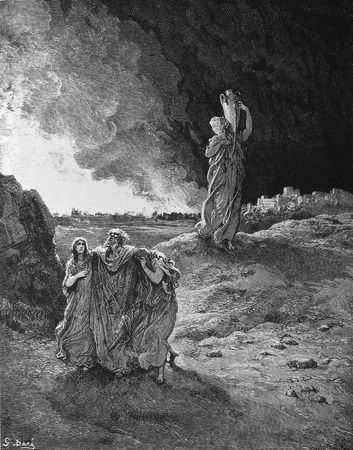Where Is Sodom Today?
Written by Joshua Travers
 The story of the destruction of Sodom is recorded in the book of Genesis. Can we confirm that it actually existed and was destroyed by God?
The story of the destruction of Sodom is recorded in the book of Genesis. Can we confirm that it actually existed and was destroyed by God?
When we think of the term sin city, we usually think of a city like Las Vegas, Nevada, which is notorious for catering to almost every vice known to man! The Bible records the story of a much older sin city, a city widely known for its depravity: Sodom (Genesis 13 and 19).
Sodom was so evil and sinful that God destroyed the city in a flash of fire. God had promised Abraham that He would spare the city if just 10 righteous people could be found within its gates (Genesis 18). Sadly, the only righteous person that God was able to find was Abraham’s nephew Lot. God helped Lot and some of his family escape from the city and then destroyed Sodom and the other cities of the plain with “brimstone and fire.”
The story of Sodom
Some view Sodom and Gomorrah as merely a fictional story with a lesson. To them, the entire Bible is fiction that contains some helpful moral principles—but shouldn’t be taken literally.
However, a closer look at the Bible reveals that Sodom was much more than just a story. The Bible talks about Sodom in such a way that there can be no doubt about the former city’s existence. For example:
- The city of Sodom first appears in the Bible as a marker for the boundaries of Canaan (Genesis 10:19).
- When Abraham suggested that he and Lot separate so there wouldn’t be strife between their herdsmen, the Bible notes that it was “before the LORD destroyed Sodom and Gomorrah” (Genesis 13:10). Such a footnote would not have been necessary if the people of the time didn’t know that Sodom had existed and been destroyed.
The story of Sodom does have a large moral lesson behind it, but that does not make it fiction. Sodom did exist, and the events that the Bible records did happen.
Where is Sodom?
For many years, archaeologists such as J. Randall Price believed that the ruins of the city of Sodom might have been discovered near the southern shore of the Dead Sea. In 1965 Paul Lapp started excavating the ancient area of Bab edh-Dhra. Various others have continued the excavations and discovered that Bab edh-Dhra was full of ash, indicating that it was burned before it was abandoned. There were also neighboring cities nearby that could have easily been Gomorrah, Zeboiim, and Admah—the other urban centers destroyed on the plain. Dr. Price discusses the reasons behind his hypothesis in his book The Stones Cry Out (1997).
There were a few arguments against these cities being the famous sin cities of the Bible. One argument was that these locations were closer to the size of villages than the massive urban areas described in the Bible. Another argument was that the destruction of the cities seems to date to almost 200 years before Abraham lived.
The most important argument against it, however, is that the geography of the city is wrong. Sodom and the other cities of the plain were located on the “plain of Jordan” (Genesis 13:10). The Jordan River flowed down into the north of the Dead Sea, so the plain of Jordan would have to be near the north of the Dead Sea, not the south where Bab edh-Dhra is located.
Sodom—found?
Another possible candidate for the ancient city of Sodom is Tall el-Hammam, an archaeological site in Jordan that is currently being excavated by Trinity Southwestern University and the Jordanian government. The excavation director, Steven Collins, is considered by some to be the world’s leading authority on the city of Sodom. This year Dr. Collins and Latayne C. Scott published a book called Discovering the City of Sodom, in which they argue that Tall el-Hammam was this ancient sin city.
The belief that Tall el-Hammam is Sodom comes principally from a close look at Genesis 13, which gives some hints as to the geography of the region. Dr. Collins has also identified the time of Sodom’s destruction with what he believes is the time of Abraham.
One of the more spectacular aspects of the dig is the gate of Tall el-Hammam. If Dr. Collins is right about the identity of this city, then the gate that has been uncovered could be the very gate that Lot was sitting at when he greeted the angelic visitors (Genesis 19:1).
Not everyone in the biblical archaeological community agrees with Dr. Collins’ assessment, and there is still some debate on the geography and the timing of Tall el-Hammam and Sodom. Despite the debate, Dr. Collins has gained a variety of supporters and has some solid reasons for the site being Sodom. Dr. Leen Ritmeyer writes, “Nowhere else have I seen such a thick layer of destruction, with collapsed walls, burnt debris, and dramatic skeletal remains, all inside a meter-thick layer of ash” (Discovering the City of Sodom, 2013, foreword). Other evidence pointing to this location being Sodom are its location, the size of the city and the fact that it had been abandoned for centuries.
Faith in God’s Word
We may never know the location of Sodom with 100-percent certainty. But even if Tall el-Hammam is verified to be Sodom, some will still argue that the city was destroyed by a natural disaster (such as a volcano or a meteorite) and not by fire from God.
Ultimately, our faith is not based on archaeological discoveries or scientific observation. Faith is defined as “the evidence of things not seen” (Hebrews 11:1). Though we cannot see the ancient cities in their former glory or witness a recording of their destruction, we can trust everything the Bible records—because God inspired it (2 Timothy 3:16)!
To learn more about the reliability of the Bible, read our article “How Do We Know the Bible Is True?” To learn more about the important moral lesson of Sodom, read “The New Morality and an Old City.”










